One way to finance expansion working capital requirements
In business, cash flow is king. A Revolving Credit Facility (RCF) is a flexible and affordable way to make sure your business always has the cash it needs to keep things ticking over. In this post, we'll take a look at what an RCF is, how it works, and how it can benefit your business.
An RCF is a type of business loan that allows you to borrow money up to a certain limit and then repay it over an agreed period of time. The big advantage of an RCF is that you only pay interest on the money you actually borrow, and you can re-borrow any money you have repaid, up to your credit limit. This makes an RCF an ideal way to manage your business cash flow, as you only pay for the money you use, when you use it.
There are a few different things to consider when taking out an RCF, such as the interest rate, repayment terms, and whether you want a secured or unsecured loan.
However, as long as you compare the different options available and find the right fit for your business, an RCF can be a great way to help you manage your cash flow.
How does a revolving credit facility work?
Whether you want a secured or unsecured loan. A revolving credit facility is a type of credit arrangement where the borrower can use and reuse the facility, up to an agreed limit. The unused portion of the facility can be drawn down as and when needed, as long as the limit is not exceeded.
With a revolving credit facility, the interest is calculated on the outstanding balance, meaning that the monthly repayment amount can go up or down depending on how much of the facility is used.
There are two main types of revolving credit facilities - those with a fixed interest rate and those with a variable interest rate.
- Fixed interest rates will mean that the monthly repayments will stay the same, regardless of how much of the facility is used.
- Variable interest rates will mean that the monthly repayments will fluctuate, depending on the interest rate at the time.
How can a revolving credit facility benefit your business?
There are a number of benefits to using a revolving credit facility.
- One is that it can provide a source of emergency funding. If an unexpected expense arises, the borrower can draw on the facility to cover the cost.
- Another benefit is that it can help to improve cash flow. By having a source of funding that can be tapped into as and when needed, the borrower can better manage their cash flow.
There are also some drawbacks to using a revolving credit facility. One is that it can be easy to get into the habit of using the facility to cover everyday expenses, rather than saving for them. This can lead to the borrower accumulating debt and interest charges.
Another drawback is that the interest rate on a revolving credit facility is usually higher than other types of credit, such as a business loan.
Overall, a revolving credit facility can be a useful tool for businesses and individuals, but it is important to be aware of the risks and costs associated with it.
How does your business qualify for a revolving credit facility?
There are a few things that lenders will generally look for when considering whether or not to approve a business for a revolving line of credit.
The business will need to have been in operation for at least one year, and it will need to have a good history of financial management. The business will also need to have a strong business model and a solid plan for using the line of credit. Lenders will also want to see that the business has a good credit history. They will want to see that the business has a good track record of making payments on time and that it has a low level of debt. Lenders will want to see that the business has a clear purpose for taking out the loan and that it has a plan for repaying the debt. The business should also be able to demonstrate that it has the financial resources to repay the loan.
